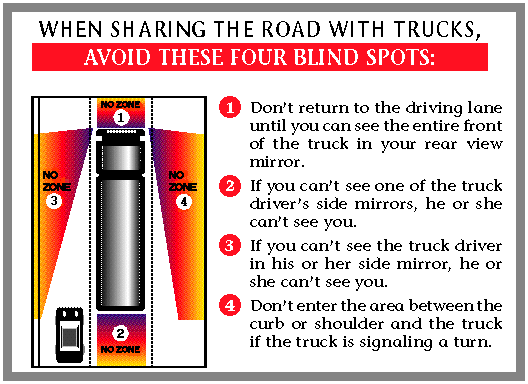Avoid Truck Accidents: Sharing the Road
On July 1st, 2017, a semi-truck collided with another vehicle on Interstate 80 nearing Interstate 55 resulting in the death of the truck driver. Recent and fatal truck accidents show the importance of sharing the road effectively with semi-trucks.
Aside from their large size, semi-trucks face numerous issues on roadways. Truck drivers have difficulty seeing vehicles in their many blind spots. Semi-trucks also struggle with maneuverability when emergencies happen on road ways.
The Illinois Department of Transportation’s Division of Traffic Safety, recently renamed the Division of Transportation Safety, conducted a study to investigate truck accidents. They collected information regarding roadway collisions between semi-trucks and other vehicles. The goal was to determine when they are most likely to occur. According to the study, semi-truck and other vehicle collisions most likely occur on Tuesdays, Wednesdays, Thursdays, and Fridays. Additionally, most accidents happen between 11:00am to 5:00pm during periods of clear, dry weather. Some of the reasons for the accidents include driving excessively over or under the speed limit and the improper use of roadway lanes. Also, driver errors cause many accidents due to tiredness and consuming alcohol. The truck drivers most likely involved in these collisions range from the age of 28 to 43 years old. Car drivers involved range from the age of 20 to 30 years old.
The SMART Initiative
Given these issues and the others that exist, the Illinois Department of Transportation has created the SMART initiative. SMART stands for Safe Motorists Always Respect Trucks. Illinois wants to decrease the number of fatal truck accidents.
The specific piece of advice that the Illinois Department of Transportation gives drivers in regards to sharing the road with semi-trucks is to avoid the truck’s blind spots. Trucks have four main blind spots.

- Image made by IDOT
Zone 1
Zone 1 is directly in front of the semi-truck. Drivers are encouraged to not return to the driving lane until the driver can see the entire front of the semi-truck in their rear-view mirror. This distance is a safe buffer zone. The distance ensures that the driver will not hit the semi-truck when crossing over to the other lane.
Zone 2
Zone 2 is directly behind the semi-truck. A good rule of thumb for sharing the road with semi-drivers: if you cannot see the truck driver in her mirror, then she cannot see you in your vehicle. Moving your vehicle just to right or left side of the semi-truck puts a driver’s vehicle in view of the truck driver’s mirror and therefore out of the truck driver’s rear blind spot.
Zone 3
Zone 3 is a triangular area to the left of the semi-truck. The same rule of thumb for driving behind a semi-truck applies to this area. If you cannot see the truck driver in their mirrors, then they cannot see you.
Zone 4
Zone 4, like Zone 3, is a triangular area to the right of the semi-truck. However, rather than it being an area where the semi-truck cannot see a driver, this area is the area between the curb and the shoulder of the road. According to the Illinois Department of Transportation, drivers should not enter this area if a semi-truck is signaling a turn.
Other Tips to Avoid Truck Accidents
While acknowledging the blind spots of semi-trucks, there are a few other aspects to keep in mind when sharing the road.
Maintain a proper following distance
Just as when driving with other standard size vehicles, it is important to give semi-trucks adequate following space. In order to come to a complete stop, semi-trucks need at least twice the amount of space than a typical car. This makes drivers more likely to rear end semi-trucks than the opposite. TLD Logistics Services recommends that drivers maintain at least a four second following distance.
Use caution when passing or merging on roadways
Truck drivers face problems when it comes to seeing other vehicles turn signals and when other vehicles are passing. Knowing what areas truck drivers have blind spots helps facilitate a driver’s ability to maneuver effectively without putting themselves (and others) in harm’s way.
Be courteous and give the trucks necessary space
Due to semi-trucks’ large size, truck drivers have difficulty making turns, changing lanes, and merging. Being in a nimbler vehicle, drivers should give truck drivers plenty of room, stay in sight of the truck driver, and effectively utilize turn signals when necessary.
By following these tips, both vehicle drivers and truck drivers can lessen the likelihood for collisions on roadways.














